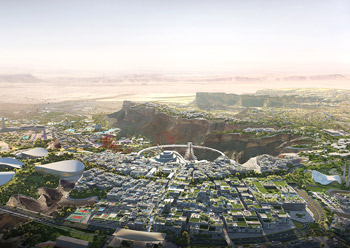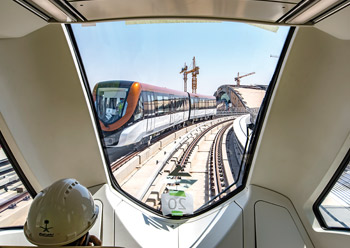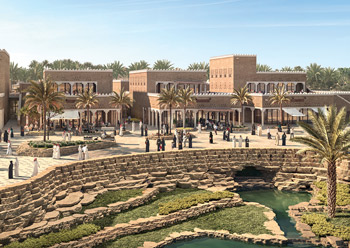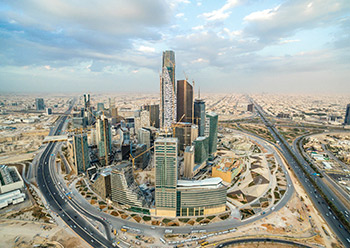
 The $10-billion Qiddiyah Project ... being built from scratch.
The $10-billion Qiddiyah Project ... being built from scratch.
The past two years have been transformational in Riyadh’s history; the kingdom’s ambitions outlined under Saudi Vision 2030 have begun to take root as the Saudi capital gears up to cater to an expected doubling of its population and provide the right ingredients to create one of the world’s most liveable cities.
As part of this vision, the Royal Commission for the City of Riyadh is expected to flag off later this year the $27-billion Riyadh Metro and Bus project, the capital city’s ambitious public transit network which has been implemented in a single phase (see Page 34).
Entertainment, sports and arts – which traditionally have taken a backseat in Saudi Arabia – will be centre stage with the development of the $10-billion Qiddiyah Project. The kingdom’s new entertainment capital is being built from scratch across 334 sq km in the southwest of Riyadh. It has already attracted key enablers such as namely Six Flags Theme Park to help translate the vision for this hub, which will also host a Jack Nicklaus-designed golf course among its innumerable attractions (see Page 43).
.jpg) |
|
Riyadh Metro ... the ambitious project is set to launch operations this year. |
Another unique destination will be Diriyah Gate, which will be centred around At-Turaif, the country’s Unesco World Heritage site. This 7-sq-km heritage and tourism destination aims to attract more than 25 million visitors annually and appeal to the local population of Riyadh as well as inbound global audiences (see Page 39).
Despite the Covid-19 pandemic challenges plaguing the world, Saudi Arabia late last year announced a SR3-trillion ($800 billion) plan to double the size of its capital in the next decade and transform it into an economic, social and cultural hub for the region.
The ambitious plan entails the creation of a mega industrial zone focusing on advanced technology such as renewables and automation, and biotechnology and aquaponics; and sustainability, with energy conservation, the circular carbon economy, and water management, according to Fahd Al Rasheed, President of the Royal Commission for the City of Riyadh.
Al Rasheed announced these plans while unveiling the ambitious strategy for the Saudi capital, ahead of key meetings of the U20, the arm of the G20 leaders’ summit that deals with urban development and strategy, last year.
.jpg) |
|
King Salman Park will be among the biggest city parks worldwide. |
“Riyadh is a very important economic engine for the kingdom, and although it’s already very successful, the plan now, under Vision 2030, is to actually take that way further, to double the population to 15 million people,” he stated.
According to him, around $250 billion in investment is expected from the private sector, with the same amount generated by increased economic activity from population growth, finance and banking, cultural and desert tourism, and leisure events.
“We’ve already launched 18 megaprojects in the city, worth over SR1 trillion to both improve livability and deliver much higher economic growth so we can create jobs and double the population in 10 years,” he added.
Among the mega projects for which Riyadh is seeking investment are the King Salman Park, Sports Boulevard, Riyadh Art and Green Riyadh, which were launched in March 2019 as part of Saudi Vision 2030 to position the capital among the world’s top 100 most liveable cities.
 |
|
Diriyah Gate ... to reflect Nadji architectural style. |
Covering over 13 sq km, King Salman Park will be among the biggest city parks worldwide. “You will see seven million trees planted in Riyadh in the next few years, and King Salman Park will be bigger than Hyde Park in London,” remarked Al Rasheed.
According to him, Riyadh is also aiming to become a Middle East artistic and cultural hub. “An opera house is being considered, as well as public art shows with 1,000 works commissioned from around the world. We have not seen anything like it since Renaissance Florence,” Al-Rasheed told Arab News.
Art Riyadh will see the installation of than 1,000 artworks and landmarks, created by local and international artists, across the city of Riyadh.
Meanwhile, Sports Boulevard extends 135 km across Riyadh, connecting Wadi Hanifah valley in the west with Wadi Al Sulai valley in the east and is expected to feature green pedestrian pathways, special routes for professional and amateur cyclists and horse riding routes.
And the Green Riyadh Project, which is already being implemented, includes planting 7.5 million trees across the capital in gardens, parks, mosques, schools, healthcare facilities, King Khaled International Airport and most of the city’s roads, streets, car parking spaces, and valleys.
Housing
Housing is another area of interest and to spearhead development in this field the kingdom’s wealth fund Public Investment Fund (PIF) set up Roshn to deliver quality residential neighbourhoods to Saudi nationals as part of its commitment to supporting the kingdom’s Vision 2030 goal of increasing the rate of homeownership in the country to 70 per cent.
The real estate developer’s first community is Roshn Riyadh, which is coming up on a 20-million-sq-m area near King Khalid International Airport and will eventually feature over 30,000 homes.
Roshn is planning to start off-plan sales at its flagship project later this year, with the handover of the first homes likely in early 2022, reported Arab News.
“The project’s first phase involves 4,000 homes that will become available for sale by the middle of this year,” said Roshn’s Group CEO David Grover.
Meanwhile, the National Housing Company, the investment arm of the Saudi Ministry of Housing, has signed a partnership with Saudi developer Al Akaria to help boost home ownership among Saudi nationals.
As per the deal, the ministry’s beneficiaries will get an opportunity to own residences within its 557-unit Al Dhahia project being developed over a 430,300-sq-m area in east Riyadh.
Al Akaria had last year collaborated with Arabian Dream, principally owned by Triple Five Worldwide, to develop the world’s largest mixed-use entertainment and shopping centre development of its kind at Akaria’s Al Widyan site in Riyadh. The new destination, which is estimated to cost $5 billion will boast major theme parks, water parks, recreational and sports facilities, retail dining, shopping centres and hospitality components.
Another housing project being developed in partnership with the private sector is Jawharat Al Sahab (Jewel of the Clouds, in Arabic), a key residential development featuring 171 homes in the Twaiq district of Riyadh.
According to senior officials, 21 housing projects are being developed throughout the capital city to provide more than 29,000 residential units including villas, apartments and townhouses.
Of these, 11 are within Al Jawan, the largest residential suburb located in the north of Riyadh and extends over a total area estimated at 11 million sq m, near King Khalid International Airport.
Airport
As part of its transport infrastructure, Riyadh is upgrading the King Khalid International Airport (KKIA). Most of the airside infrastructure will be redeveloped, including the two runways, taxiways, cargo aprons and isolated parking positions. The entire airfield ground lighting (AGL) equipment and systems will be replaced by a LED lighting system with a dedicated IT control system. Work includes infrastructure, Navaids and an upgrade of baggage handling systems at Terminals 3 and 4.
The kingdom, however, is reported to have put on hold financing plans for a multibillion-dollar expansion of Riyadh’s airport, as it re-assesses priorities after the coronavirus crisis.








.jpg)




.jpg)




























.jpg)





































